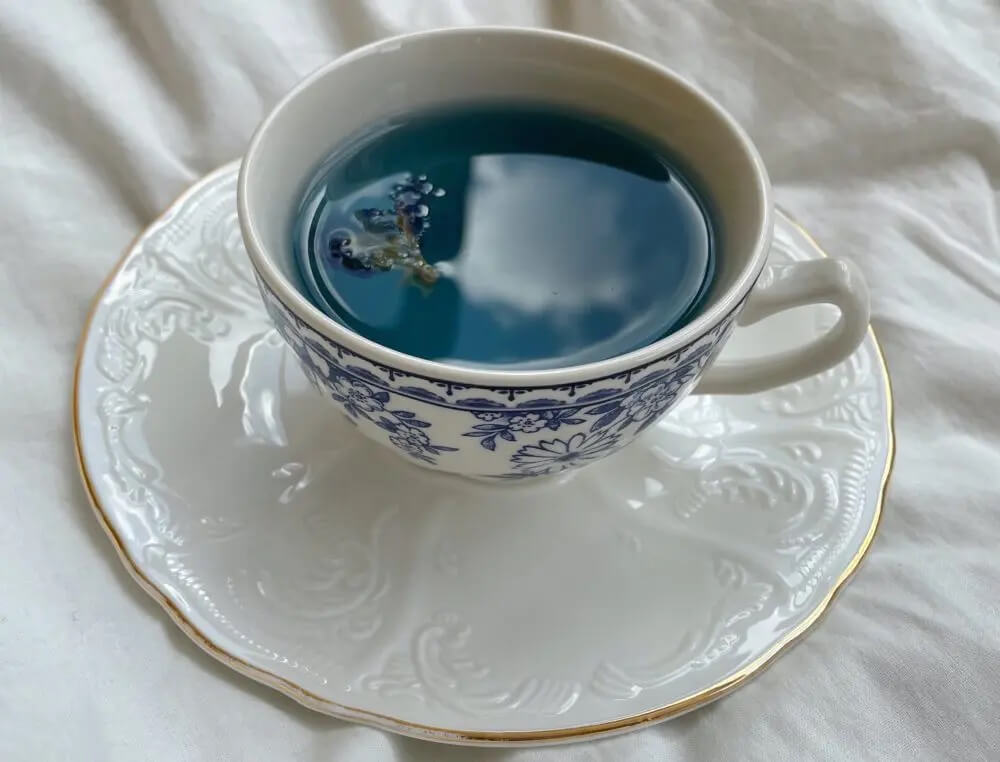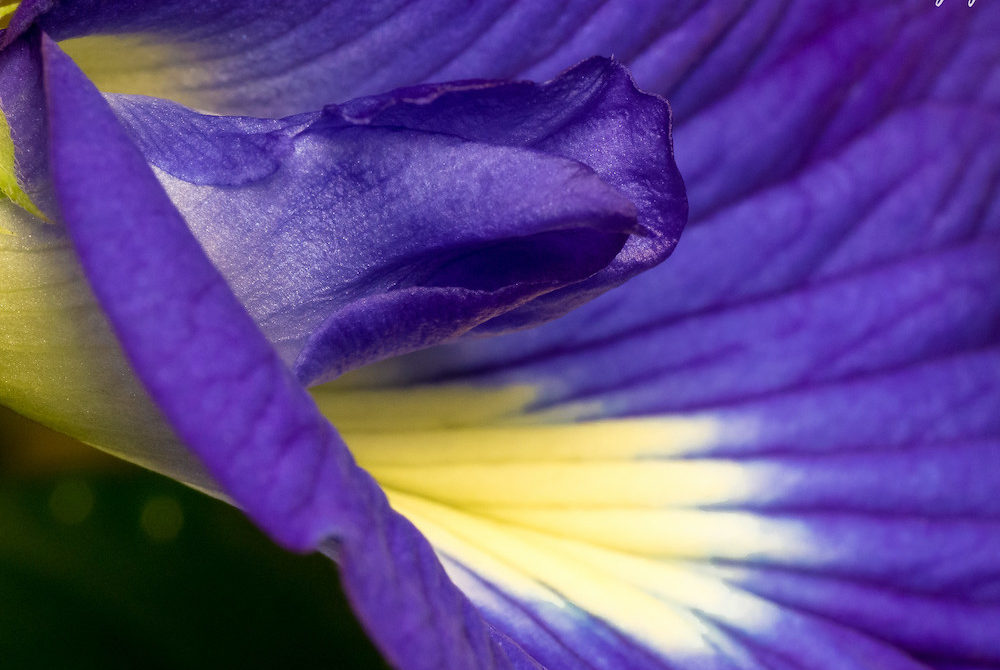Have you heard about blue tea? Recently, Anchan Tea, also called Blue Clitoria and Blue Butterfly Pea (Clitoria Ternatea), is attracting more and more interest worldwide. Butterfly Pea Tea, as it is called in English, is an ancient herbal plant from Southeast Asia. The flower not only looks beautiful, it has also made a name for itself as a remedy in Thai medicine. Leaves, flowers, seeds and roots can be used as medicinal herbs.
A flower that has been used as a medicinal plant in Ayurvedic teachings for centuries must have extraordinary properties. In fact, there are plenty of benefits. But more about that later…
The first thing that is impressive is the color. When the flowers are infused with hot water, the drink turns a beautiful blue. Add a few squirts of lemon and the blue changes to a fascinating purple.
This characteristic makes butterfly flower a popular ingredient for cocktails. Due to the wonderful color change, the blue clit is causing more and more sensation in the trendy gastronomy multinationally. Increased digital media coverage is creating even more popularity.
The hot or cold tea is extremely thirst quenching, tastes earthy and not as spectacular as the famous color may promise. Now, if you add lemongrass, gin, white cane sugar syrup, soda, honey, coconut water, cold cocoa – the sky’s the limit to your imagination – Blue Tea is guaranteed to become your special favorite drink.

The pretty appearance is one thing, but what else is behind this fascinating flower?
In the course of the last decades we have already got to know the most different kinds of tea. Chamomile, elderberry, peppermint, nettle, sage and not to forget the green and white tea. Some soothe the stomach, others relieve sore throats, and still others help with gingivitis and other aches and pains.
Drinking a few cups of tea every day, regardless of the seasons, has a positive effect on our health.
People have different tastes, this has to do with our genes. That is why, for example, one person likes green tea and the other does not like it at all. We love Anchan tea in all its varieties.
What else does blue tea do?
Read on and you will be surprised how many health benefits the butterfly flower brings.
- Strengthens the immune system (helps with coughs, colds and asthma)
- acts like paracetamol (it is believed that blue tea helps to reduce fever)
- Stress relieving (a high dosage has a positive and anti-anxiety effect)
- Anti-inflammatory (blue flowers are rich in flavonoids, these are powerful antioxidants with anti-inflammatory properties)
- Promotes memory (studies have shown that the flowers support memory and brain function. As they help increase acetylcholine, a neurotransmitter).
- Reduces cell damage (the vibrant color of the tea indicates the high levels of antioxidants. These reduce the risk of cell damage and slow the aging of skin and hair).
- Helps with type II diabetes (inhibits the absorption of glucose from food). Researchers assessed the link between anthocyanin consumption and type II diabetes by examining data from more than 200,000 men and women who had participated in long-term health studies. Dr. Walter Willett, professor of epidemiology and nutrition at the Harvard School of Public Health found that higher consumption of anthocyanins was associated with a lower risk of type II diabetes.
- Improving vision (Clitoria ternatea contains an antioxidant called proanthocyanidin, which improves blood flow to the capillaries of the eye, this in turn is useful in treating glaucoma, blurred vision, retinal damage, and tired eyes)
- Aphrodisiac effect in women
- Helps with menstrual pain
- Anti-HIV action (Butterfly Pea is one of the few plants containing cyclotides that have shown anti-HIV action in studies)
- Lowers high blood pressure (blue tea promotes normal urination, which in turn lowers blood pressure)
- Anticonvulsant (butterfly pea has been shown to help reduce the severity and burden of convulsions on the body. This is very helpful in the treatment of epilepsy
- Anti-cancer/anti-tumor (The cyclotides of Clitoria Ternatea can cause the death of cancer cells by disrupting the integrity of cell membranes).
Anthocyanins are therefore the magic word.

What are anthocyanins?
Anthocyanins are nature’s most powerful antioxidants. They are water-soluble plant pigments that are also found, for example, in cherries, blue grapes, blueberries, acai berries, chokeberry and red cabbage. Fruits and vegetables in the colors blue, red, purple. Intense beautiful colors that emphasize the motto “the more colorful, the healthier”.
The benefits of this blue magic are not only internal, but also external. Blue tea is also known for its anti-aging effects due to its high antioxidant content. This super drink is also great for the hair. Anthocyanins, a compound known to increase blood circulation in the head, thus ensuring a healthy scalp. The flavonoids contained in blue tea can also stimulate collagen production, helping to develop and maintain skin elasticity.
This caffeine-free herbal drink not only looks beautiful, it helps our health and prevents skin aging. For this reason, manufacturers also use butterfly pea in cosmetics and as a natural dye for food and textiles.
In Southeast Asia, butterfly pea is used as a natural food coloring in traditional cooking. For many Thai desserts, butterfly flowers are squeezed to extract their blue color, then mixed with coconut milk and other basic ingredients. This naturally produces many delicacies in the colors of blue and purple.
“Nam Dok Anchan” is a refreshing syrupy drink in beautiful indigo blue. It is made of butterfly flowers, honey and sugar syrup.
In Burmese, as well as Thai cuisine, the flowers are also dipped in batter and deep fried. In Malay cuisine, when cooking white rice, locals add a few buds of the blue flower to the pot to give the rice a bluish color.
How to prepare blue tea?
- 5-10 flowers, fresh or dried, pour hot water in a large cup.
- Leave to infuse for 10-15 minutes.
- Strain the liquid and discard the flowers.
- Delight in the indigo color.
- Use imagination (add lemon or lime juice and honey. The color of the tea will change to a bright purple).
- When experimenting with cocktails, let the tea cool first.
Is it possible to drink too much Anchan tea?
Blue tea does not contain caffeine, this definitely excludes the risk of caffeine shock. As mentioned earlier, anthocyanins are found in Blue Tea, which promote blood flow to the head. Its soothing taste and aroma make this super tea a great stress killer. There are no known side effects of Anchan tea. As always, everything should be taken in moderation. But we advise limiting consumption to 2-3 cups per day.
In Thailand, the drink is often served at check-in/reception in hotels, spas and massage parlors. Keep an eye out for it…
Where can I buy blue tea?
Of course, this tea is available on Amazon. This link will take you to an overview of all suppliers of blue tea. Have fun browsing 😉
Further links to butterfly blue tea
- The benefits and side effects of blue tea on healthline.com.
- 11 benefits of blue tea on the Qi.
- How to make butterfly tea (recipe from Nart)
- Flavonoid intakes and risks in US men and women on National Library of Medicine
